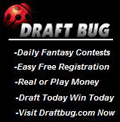RotoGuru Menu
![]() Daily blurbs
Daily blurbs
![]() Message Forum
Message Forum
![]() Forum Keepers
Forum Keepers
![]() Sponsorship
Sponsorship
![]() Troubleshooting
Troubleshooting
Football Pickoff
![]() Login
Login
![]() Standings
Standings
Football
![]() NFL Schedule
NFL Schedule
![]() Field Goals
Field Goals
![]() Player Lookup
Player Lookup
TSN Football
![]() Sortable TSN Stats
Sortable TSN Stats
![]() Weekly TSNP
Weekly TSNP
![]() Team Rankings
Team Rankings
![]() Assimilator
Assimilator
RotoHog Football
![]() Sortable RotoHog Stats
Sortable RotoHog Stats
![]() Weekly RHP
Weekly RHP
 |
Basketball
![]() Hoop Pointers
Hoop Pointers
![]() Player Lookup
Player Lookup
NBA Schedule
![]() Full Season
Full Season
![]() Next 4 weeks
Next 4 weeks
![]() Sched-O-Matic
Sched-O-Matic
TSN Hoops
![]() TSN Stats
TSN Stats
![]() Yesterday's TSNP
Yesterday's TSNP
![]() Team Rankings
Team Rankings
![]() Assimilator
Assimilator
NBASE
![]() NBASE Stats
NBASE Stats
![]() Yesterday's RHP
Yesterday's RHP
Market Madness
![]() Contest Site
Contest Site
![]() Rules
Rules
![]() Historical Stats
Historical Stats
![]() Recap of Entries
Recap of Entries
![]() Unit Returns
Unit Returns
![]() Standings
Standings
 |
Baseball
![]() MLB Schedule
MLB Schedule
![]() Base Advances
Base Advances
![]() Player Lookup
Player Lookup
TSN Baseball
![]() Sortable Stats
Sortable Stats
![]() Yesterday's TSNP
Yesterday's TSNP
![]() Team Rankings
Team Rankings
![]() Assimilator
Assimilator
RotoHog Baseball
![]() Sortable Stats
Sortable Stats
![]() Yesterday's RHP
Yesterday's RHP

Draft Bug Baseball
![]() Sortable Stats
Sortable Stats
![]() Yesterday's DBP
Yesterday's DBP
General
![[RotoGuru logo]](http://rotoguru2.com/images/gfs2.gif)
Fantasy Strategy Ideas from the Guru
Position Points
I often like to plot the price vs. SWP/game average for Smallworld games. In many cases, the picture "points out" certain features that are more obscured when looking at just the raw numbers.
The graph below plots the Small World Hoops Price on Jan. 16, 2000 versus the corresponding player's average SWP/game over the past 15 days. Inactive players are excluded, as are many of the marginal producers. Price is shown along the x axis, and SWP/G appears vertically. The general shape of the scatterplot is familiar to those of you who have seen similar graphs from prior seasons. The trend goes from lower left to upper right, which is intuitive. The points are color coded by position. A few points are labeled, to help you get your bearings.

As a general rule, the most efficient players to own are those whose points fall along the top edge of the cluster. These players produce the most points for the money. You could appropriately define this top edge as the "efficient frontier".
The blue point in the upper right extreme represents Shaq. Note how lonely he is out there! There are no other blue points within shouting distance. Meanwhile, there are several forwards in his point neighborhood, and at materially lower prices. Also, the two most expensive guards (Kidd and Payton) are in the same price range as the top forwards, but they haven't been producing at the same pace of late. It would almost seem that the best way to organize your roster is to stay away from Shaq and the top guards, and allocate your forward money to the highest SWP producers.
But that assessment fails to consider the entire picture. Look further to the left. The cheap end of the efficient frontier is also dominated by forwards. If you tie up a lot of roster slots and capital with expensive forwards, then you can't take advantage of this cheap source of points. You are left to buy the cheaper blue and green points. And on average, this results in slightly inferior roster composition, as the production which is sacrificed by owning cheap guards and centers is greater than the benefits from owning the top forwards.
This "points out" why Shaq still represents good value at his lofty price. Ditto for the better guards. The cluster of guards around the $9-10 million mark represents excellent relative value, as they pretty much define the efficient frontier at that price range. If you load up on lower priced forwards, you have more money to spend on the other positions. At almost any roster value, you can generate the most total points by owning cheaper forwards, mid-to-high priced guards, and Shaq.
That doesn't mean that you should never own a top forward. Wealth, scheduling, hot streaks, matchups, trade availability - all of these factors should weigh in the decision, and especially for wealthier teams, some of the top forwards clearly make sense. It also helps to preserve trading flexibility if you can own players at different price levels at each position. In fact, if some of the top forwards continue to put up "Shaq-like" numbers, you'll probably want to own them in lieu of the most expensive guards. Some of the wealthiest teams will ultimately be able to own players exclusively from the upper right. In fact, that's the ultimate objective in generating value gains.
What about price potential? The attractive relative value offered by the cheaper forwards works against their price upside. There are just too many options, and if one of them starts a nice run-up in price, many managers will cash out the gains and redeploy in a cheaper forward. This provides good short term trading opportunities, but it also makes it tough for these players to produce sustained gains. And that's why the color patterns on this graph will probably remain pretty much the same throughout the season, even though many of the names along the efficient frontier will change from period to period. Shaq should hold his lofty price because of the scarcity of comparable producers at his position. Meanwhile, the abundance of similarly priced forwards at any spot along the efficient frontier will inhibit the ability of their price ratios to reach those of comparable players at the other positions.
RotoGuru is produced by Dave Hall (a.k.a. the Guru), an avid fantasy sports player. He is not employed by any of the fantasy sports games discussed within this site, and all opinions expressed are solely his own. Questions or comments are welcome, and should be emailed to
Guru<davehall@rotoguru2.com>.© Copyright 1998-2008 by Uncommon Cents, LLC. All rights reserved.
